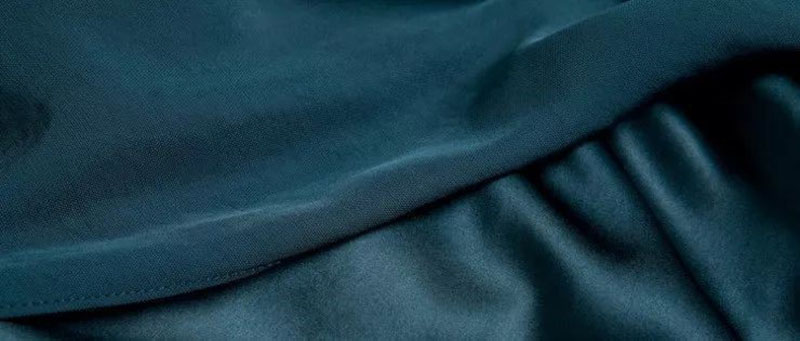Cellulose Acetate, CA for short.Cellulose Acetate is a kind of man-made fiber, which is divided into diacetate fiber and triacetate fiber. The chemical fiber is made of cellulose, which is converted into cellulose acetate by chemical method. It was first prepared in 1865 as cellulose acetate. It is a thermoplastic resin obtained by esterification of cellulose with acetic acid or acetic anhydride under the action of catalyst. It is a chemically modified natural polymer obtained by esterification of hydroxyl in cellulose molecules with acetic acid. Its performance depends on the degree of acetylation.
01. Classification of CA
The cellulose can be divided into diacetate fiber and triacetate fiber according to the degree of hydroxy substitution by acetyl group.
Diacetic acid is formed after partial hydrolysis of type I acetate, and its esterification degree is lower than that of type III acetate. Therefore, the heating performance is lower than that of the three vinegar, the dyeing performance is better than that of the three vinegar, and the moisture absorption rate is higher than that of the three vinegar.
Triacetic acid is a type of acetate with high esterification degree without hydrolysis. Therefore, it has strong light and heat resistance, poor dyeing performance and low moisture absorption (also known as moisture regain).
In the molecular structure of acetate fiber, the hydroxyl group on cellulose glucose ring is replaced by acetyl group to form ester bond. The esterification degree of diacetate fiber is lower than that of triacetate fiber due to hydrolysis. Diacetate fiber has a large amorphous area in the supramolecular structure, while triacetate fiber has a certain crystalline structure, and the symmetry, regularity and crystallinity of fiber macromolecules are higher than diacetate fiber.
02. Properties of acetate fiber
Chemical properties
1. Alkali resistance
The weak alkali agent did not cause damage to the acetate fiber, and the weight loss rate of the fiber was very small. After encountering strong alkali, especially diacetate fiber, it is easy to deacetylate, resulting in weight loss, strength and modulus also decrease. Therefore, the pH value of the solution for treating acetate fiber should not exceed 7.0. Under standard washing conditions, it has strong chlorine bleaching resistance, and can also be dry cleaned with tetrachloroethylene.
2. Resistance to organic solvents
Cellulose acetate is completely dissolved in acetone, DMF and glacial acetic acid, but not in ethanol and tetrachloroethylene. According to these characteristics, acetone can be used as the spinning solvent of acetate fiber, and tetrachloroethylene can be used for dry cleaning of acetate fiber fabrics.
3. Acid resistance
CA has good acid resistance stability. Common sulfuric acid, hydrochloric acid and nitric acid will not affect the strength, luster and elongation of the fiber within a certain concentration range; But it can be dissolved in concentrated sulfuric acid, concentrated hydrochloric acid and concentrated nitric acid
4. Dyeing
Although acetate fibers are derived from cellulose, a large part of the polar hydroxyl groups on the cellulose glucose ring are replaced by acetyl groups to form esters during esterification. Therefore, dyes commonly used for dyeing cellulose fibers have almost no affinity for acetate fibers and are difficult to dye. The most suitable dyes for acetate fiber are low molecular weight disperse dyes with similar dye uptake rates.
Acetate fiber or fabric dyed with disperse dyes has bright color, good leveling effect, high dye absorption rate, high color fastness and complete chromatography.
physical property
1. CA not only has certain water absorption, but also has the property of rapid removal after water absorption
2. The thermal stability of acetate fiber is good. The glass transition temperature of the fiber is about 185 ℃, and the melting termination temperature is about 310 ℃. At the end of the temperature rise, the weight loss rate of the fiber is 90.78%; The breaking strength of acetate fiber is 1.29 cN/dtex, while the strain is 31.44%.
3. The density of CA is smaller than that of viscose fiber, which is close to that of polyester fiber; The strength is the lowest of the three fibers.
4. CA has relatively good elasticity, similar to silk and wool
5. Boiling water shrinkage is low, but high temperature treatment will affect the strength and luster of the fiber, so the temperature should not exceed 85 ℃
Advantages of Cellulose Acetate
1.Diacetate fiber has good air permeability and anti-static property
In the environment with relative humidity of 65%, diacetate has the same moisture absorption as cotton, and has better quick drying performance than cotton, so it can well absorb the water vapor evaporated by the human body and discharge it at the same time. So that people feel comfortable. At the same time, good moisture absorption performance can reduce the accumulation of static electricity, which is not easy to produce static electricity.
2. Diacetate fiber has a soft touch
The initial modulus is low, and the fiber is weak and flexible under the action of small load, showing a soft character, so the skin has a soft and comfortable feeling. But if the initial modulus is too low, it will be weak.
The initial modulus is high, and the fiber is rigid and not easy to bend under the action of small load, showing a stiff character.
3. Diacetate fiber has outstanding deodorization performance
Why does acetate fabric have a good appearance?
1. Diacetate fiber has soft luster like pearl
The cross section of mulberry silk is irregular triangle, and the cross section of acetate fiber is irregular concave convex. Both of them have longitudinal stripes on their longitudinal sections, making their transverse light diffuse and longitudinal light diffuse. The refractive index is low, 1.48. So mulberry silk and presents a soft luster like pearl.
2. Cellulose Acetate has excellent drapability
The initial modulus of fiber is 30-45cn/dtex, the rigidity is weak, the cross section is irregular concave convex, the fabric is soft, and the draping feeling is good
3. Diacetate fiber has bright colors and color fastness
Acetate fiber color, complete chromatography, full and pure color, excellent color fastness.
4. Acetate fiber has good dimensional stability
Vinegar fiber has low expansion to water, so it has good dimensional stability after being made into fabric to maintain the beauty of clothing.
5. Diacetate fiber has relatively balanced antifouling property
For dirt with dust, water and oil, it is not easy to be contaminated and easy to clean
Post time: Nov-22-2022




